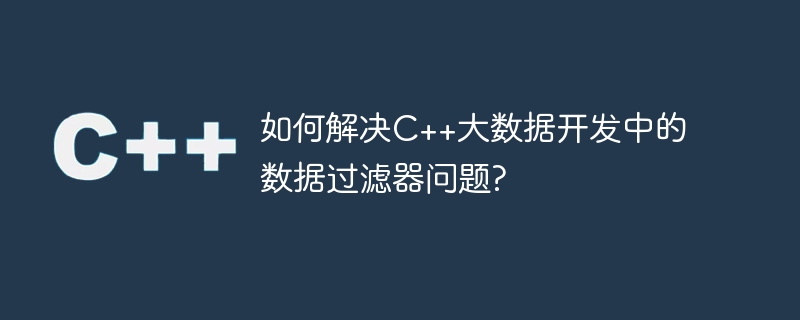

How to solve the data filter problem in C big data development?
Introduction: In C big data development, we often need to filter massive data in order to Filter out data that meets specific criteria for further processing. This article will introduce how to use C to write efficient data filters to improve the efficiency of big data processing.
1. Problem background:
In big data development, we usually encounter the need to filter large amounts of data based on specific conditions. For example, in the financial industry, we want to filter out transaction records exceeding a certain amount; in the e-commerce industry, we want to filter out the product sales data of a specific brand, etc. When processing large amounts of data, traditional traversal methods for filtering will be very inefficient. Therefore, we need an efficient data filter to solve this problem.
2. Problem solution:
In C, data filtering problems can be solved by customizing the data filter class. Below we use an example to illustrate how to use C to implement a simple data filter.
#include <iostream>
#include <vector>
using namespace std;
class DataFilter {
public:
virtual bool filter(int data) = 0;
};
class GreaterThanFilter : public DataFilter {
public:
GreaterThanFilter(int threshold) : threshold_(threshold) {}
bool filter(int data) {
return data > threshold_;
}
private:
int threshold_;
};
class EvenNumberFilter : public DataFilter {
public:
bool filter(int data) {
return data % 2 == 0;
}
};
class DataProcessor {
public:
DataProcessor(DataFilter* filter) : filter_(filter) {}
void process(vector<int> data) {
for (int i : data) {
if (filter_->filter(i)) {
cout << i << " ";
}
}
cout << endl;
}
private:
DataFilter* filter_;
};
int main() {
vector<int> data = {1, 2, 3, 4, 5, 6, 7, 8, 9, 10};
// 使用大于过滤器筛选大于5的数据
DataFilter* greaterThanFilter = new GreaterThanFilter(5);
DataProcessor processor1(greaterThanFilter);
cout << "Filtering data greater than 5: ";
processor1.process(data);
// 使用偶数过滤器筛选偶数数据
DataFilter* evenNumberFilter = new EvenNumberFilter();
DataProcessor processor2(evenNumberFilter);
cout << "Filtering even numbers: ";
processor2.process(data);
delete greaterThanFilter;
delete evenNumberFilter;
return 0;
}In the above code, we define an abstract data filter class DataFilter, which declares a pure virtual function filter, which is used to determine the given Determine whether the data meets the conditions. Then, we define specific data filters by inheriting the DataFilter class and implementing the filter function. In the DataProcessor class, we pass in the filter as a parameter and use the filter to filter and process the data. Finally, we perform data filtering and processing in the main function by creating a specific filter object and passing it into the DataProcessor class.
3. Summary:
By customizing the data filter class, we can easily realize the data filtering requirements in C big data development. By passing filters as parameters into the data processing class, we can achieve efficient processing and filtering of big data. In practical applications, we can also design more complex filters according to needs and use multi-threading technology to increase the speed of data processing.
The above is an introduction on how to solve the data filter problem in C big data development. I hope it will be helpful to everyone.
The above is the detailed content of How to solve the data filter problem in C++ big data development?. For more information, please follow other related articles on the PHP Chinese website!




